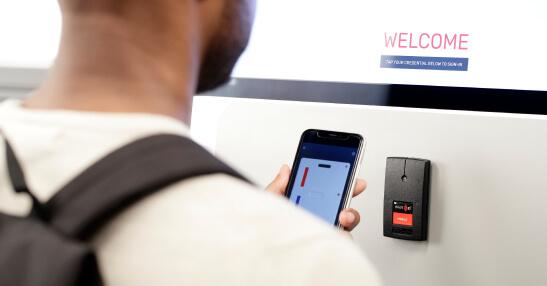3 Reasons to Replace Magnetic Stripe Card Readers Across Your Campus
Speak With An Expert
Educational institutions have long relied on magnetic stripe cards as ID credentials for students, faculty, and staff, providing access to academic buildings, libraries, fitness centers, cafeterias, printers, and other services on campus.
But despite their widespread use, magnetic stripe card readers are prone to security vulnerabilities and data breaches. As a result, many campuses are going digital, and becoming smart campuses by replacing traditional card-based systems with more secure and advanced authentication methods like contactless technology and mobile credentials.
Contactless technology unlocks streamlined and convenient interactions across campus and simplifies processes like access control, payments, and authentication without the need for physical contact — enhancing efficiency and user experience. We call this tap-and-go.
Magnetic stripe card readers, also known as magstripe readers, are devices that read data encoded in magnetic stripes on the back of credit, debit, identification, or access cards. To gain access, the user swipes the card through the reader. The reader uses magnetic sensors to interpret the information stored in the magnetic stripe, enabling transactions, access control, or identification processes.
However, magnetic stripe cards can be easily damaged by exposure to magnets, dirt, moisture, or physical wear and tear, potentially leading to data corruption or failure to read the encoded information on the magnetic stripe. Additionally, magstripe readers are more susceptible to unauthorized access or fraudulent activities because the information stored on magnetic stripes is static and can be easily copied or cloned.
On the other hand, contactless technology uses radio frequency identification (RFID) technology or near-field communication (NFC) to enable communication between devices. The technology transfers encrypted data between a contactless card, smartphone, or wearable device and a compatible reader. This facilitates swift payments, access control, or data exchange by simply holding the device close to the reader — no physical contact needed. Contactless technology also minimizes wear and tear on the card and reduces the risk of skimming or unauthorized access compared to magnetic stripe cards.
Keeping your campus secure and protecting student, faculty, and staff data requires robust solutions that aren’t easily compromised. Contactless technology offers a modern and efficient approach to enhancing convenience, speed, and security across campus operations.
Consider the following benefits of migrating from magnetic stripe card readers to contactless technology:
The transition to mobile credentials is often a seamless experience since most students already have smartphones. And unlike physical badges which are easily misplaced, students tend to protect their phones and always have easy access to them.
Mobile credentials improve the student experience because they ensure that students don’t have to worry about forgetting their ID when running late to class. From time and attendance tracking of seminars and trainings to secure printing capabilities and convenient payment options for on-campus services, contactless technology facilitates and streamlines activities across the entire campus.
Magstripe technology can expose campuses to significant cybersecurity vulnerabilities if cards are lost, stolen, or skimmed by bad actors. Instead of leaving your campus vulnerable, use mobile credentials for heightened protection against threats.
With mobile-first identity and access management, the rf IDEAS WAVE ID® Mobile Mini Reader ensures only your authorized students, faculty, and staff have access to secure systems, sensitive student records, data stored on network-connected multifunction printers, and other private information.
With a typical transaction lasting just a few seconds, adopting contactless technology presents a quick and convenient method for students to effortlessly access and pay for on-campus services like printing, cafeteria or restaurant items, health club memberships, and more.
This efficiency not only enhances service quality but also yields cost savings for both students and your institution. By eliminating the need for physical IDs, students avoid fees incurred when IDs are misplaced. Your institution benefits from reduced operating costs, eliminating expenses related to producing magnetic stripe cards and printing.
Magnetic stripe card readers leave campuses open to cybersecurity threats and bad actors waiting to take advantage. That’s why it’s time to consider adopting contactless technologies to fortify campus security measures and protect sensitive data from potential breaches or unauthorized access. rf IDEAS is compatible with the top education credential providers (including CBORD, Transact Campus, and Atrium) so you can ensure a more secure environment for students, faculty, and staff.
Ready to replace magnetic stripe cards and deploy contactless technology on your campus? Get in touch with rf IDEAS to learn more about available options.